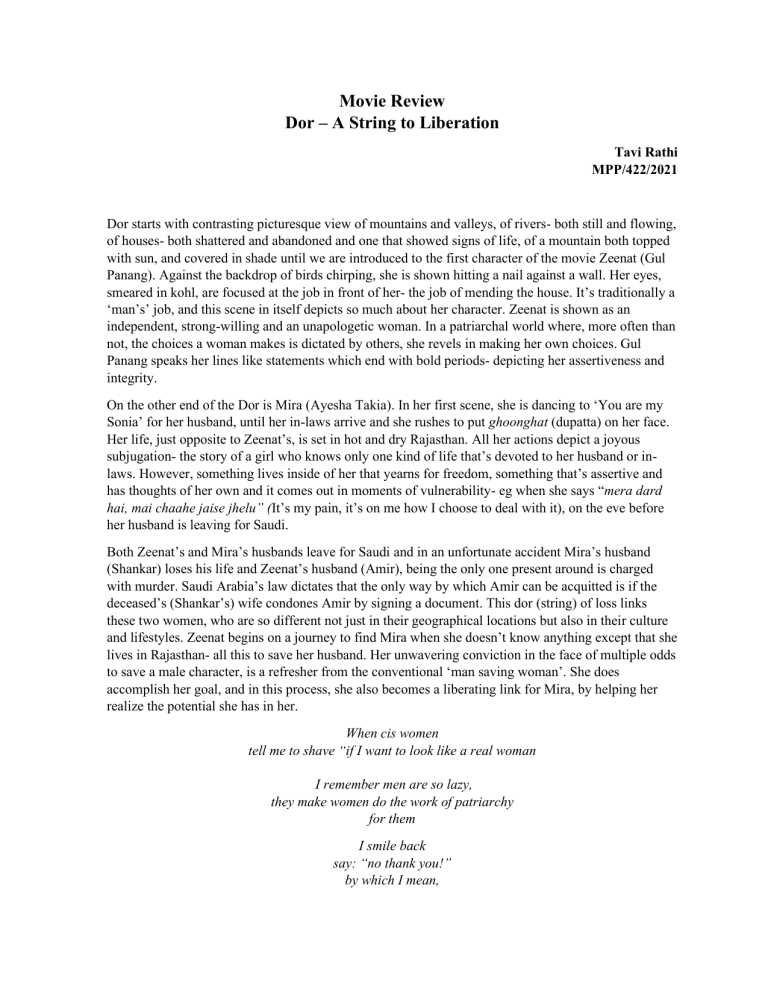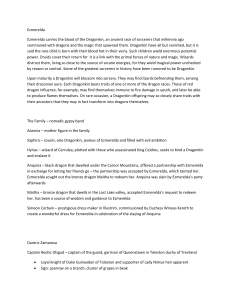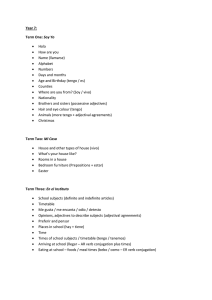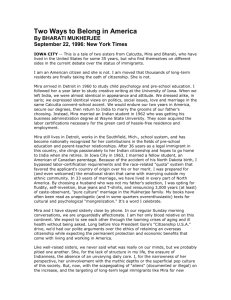
Movie Review Dor – A String to Liberation Tavi Rathi MPP/422/2021 Dor starts with contrasting picturesque view of mountains and valleys, of rivers- both still and flowing, of houses- both shattered and abandoned and one that showed signs of life, of a mountain both topped with sun, and covered in shade until we are introduced to the first character of the movie Zeenat (Gul Panang). Against the backdrop of birds chirping, she is shown hitting a nail against a wall. Her eyes, smeared in kohl, are focused at the job in front of her- the job of mending the house. It’s traditionally a ‘man’s’ job, and this scene in itself depicts so much about her character. Zeenat is shown as an independent, strong-willing and an unapologetic woman. In a patriarchal world where, more often than not, the choices a woman makes is dictated by others, she revels in making her own choices. Gul Panang speaks her lines like statements which end with bold periods- depicting her assertiveness and integrity. On the other end of the Dor is Mira (Ayesha Takia). In her first scene, she is dancing to ‘You are my Sonia’ for her husband, until her in-laws arrive and she rushes to put ghoonghat (dupatta) on her face. Her life, just opposite to Zeenat’s, is set in hot and dry Rajasthan. All her actions depict a joyous subjugation- the story of a girl who knows only one kind of life that’s devoted to her husband or inlaws. However, something lives inside of her that yearns for freedom, something that’s assertive and has thoughts of her own and it comes out in moments of vulnerability- eg when she says “mera dard hai, mai chaahe jaise jhelu” (It’s my pain, it’s on me how I choose to deal with it), on the eve before her husband is leaving for Saudi. Both Zeenat’s and Mira’s husbands leave for Saudi and in an unfortunate accident Mira’s husband (Shankar) loses his life and Zeenat’s husband (Amir), being the only one present around is charged with murder. Saudi Arabia’s law dictates that the only way by which Amir can be acquitted is if the deceased’s (Shankar’s) wife condones Amir by signing a document. This dor (string) of loss links these two women, who are so different not just in their geographical locations but also in their culture and lifestyles. Zeenat begins on a journey to find Mira when she doesn’t know anything except that she lives in Rajasthan- all this to save her husband. Her unwavering conviction in the face of multiple odds to save a male character, is a refresher from the conventional ‘man saving woman’. She does accomplish her goal, and in this process, she also becomes a liberating link for Mira, by helping her realize the potential she has in her. When cis women tell me to shave “if I want to look like a real woman I remember men are so lazy, they make women do the work of patriarchy for them I smile back say: “no thank you!” by which I mean, what could be more real than this? - Real Women, Alok Menon. Rajasthan, the entire Marwar and Mewar region, has had patriarchy imbibed in it since time immemorial. It hasn’t known any other form of society, and in a strange and a rather sad manner, it also manages becomes a cause for celebration and pride. Patriarchy, like a virulent disease, makes home in everyone in its ambit. Men in power make their job easy by imbibing in women the ideals of their subjugated role in a society. It was shown in this movie- when the grandmother called Mira’s husband a “joru ka ghulaam” (slave) and asked him to not spoil his wife so much when he volunteered to bring lassi (buttermilk) for her. It was also visible when Shankar’s mother remains antagonist to Mira throughout the film, trying to establish her authority in the little space that she could, i.e., over Mira. The news of Shankar’s death leads Mira and Zeenat to different journeys altogether- where for Zeenat, it’s the journey to find that one person in Rajasthan who can save her husband’s life, and for Mira, it is the journey from a life already characterized by subjugation, albeit joyous in some parts, to a life of servitude bereft of colors, music and anything that has a link to happiness. The contradiction, is again shown in these journeys, where Zeenat, on her own agency, sets out for a mission that’s seemingly impossible, against Mira, who loses the one part of life where she could act out of her own accord and gets her life’s terms dictated entirely by others. But even in the face of these adversities—for Zeenat, armed with only a picture and a conviction for her cause; and for Mira, being lost a day after other passes by, the director tries to convey that there’s hope. This is shown by the backdrop music “Yeh hausla kaise jhuke, yeh aarzoo kaise ruke; manzil mushkil hai toh kya, dhundala sahil toh kya’ tanha ye dil toh kya” (This courage, this desire to get what you want—it doesn’t waver. So what the road to what you want is difficult, so what the shore seems hazy and it looks like you’re alone in the waters—this courage doesn’t falter). And this, I think, becomes the first step to social transformation—hope—a light, however dim, but just present and flickering through the odds, even if you don’t know what to do or where to head next. Upon reaching Rajasthan, Zeenat crosses paths with a Behrupiya ( played by Shreyas Talpade) who comes disguised as a fortune teller to deceive Zeenat. While Zeenat sees through his acts, he manages to hoodwink her and steal her purse. However, later when Zeenat gets into trouble with strange men, he comes for her rescue and saves her by his talents in arts and mimicry, and goes on becoming a key link to find Mira. In the course of the film, Shreyas in his role as a Behroopiya takes on different appearances- ranging from policeman to tax officer, and this points to how help can come from various sources, often with no name—and how transformation is not a one person’s job, but several forces and people from different cadres working in tandem to bring about the transformation. Shreyas role in this movie is essential in one more sense. Dor is centered around women, problems that a woman faces just on account of their gender, and while it is a war that women have to fight themselves, it becomes easier when men are weaved into conversations, too. Finding a place in a society that would rather have women edge around the corners and serving only to the whims of men becomes easier when men themselves help to make space for women. One essential part of this process is realization by men that they aren’t the center of this transformation, and they’re only helping. And this is shown beautifully in the movie with the nuance that while Shreyas helps Zeenat find Mira and get her to sign the document, he never tries to hold or hog the center place. Zeenat and Shreyas finally pin down the city, the village, and the house by making educated guesses. However, upon reaching the house, as Zeenat tries to explain to Shankar’s family how Amir’s death was an accident and not a deliberate murder, they force her out of the house. But Zeenat, with her stoic demeanor, tries to figure out other ways to reach Mira. Shreyas, in his role as a Behroopiya, takes this task and tries to find a window when Mira is alone and can be spoken with. This task opens his eyes to the lives of women and everything they have to endure. Lives of widowed women do not have the slightest hint of color, happiness or independence. The fact that this empathy, albeit essential for transformation, comes only when he follows Mira shows how people in power rarely acknowledge their privileges—and how inclusive and better world would be if people start to acknowledge their privileges on account of things associated with them with just the mere accident of birth. Mira steps, nay, is allowed to step out of the house, just once in the day to visit a nearby temple. Zeenat meets her there, and their interactions over time turn them into friends. Mira, in this process, rediscovers parts of her that society decolored and took away from her over the years, especially in the aftermath of Shankar’s death. In one scene, on her way to temple, she hears a song she likes after a long time and she looks around to confirm if anyone’s looking, and just slips in a few dance steps as she walks to the temple. She loves to dance, and it’s for the first time she danced, and felt liberated, if only for a moment, ever since her husband left for Saudi. However, deep rooted conditioning resurfaces, and she’s conflicted about her actions- about how only recently her husband has died and she is here, dancing. It shows how years of conditioning leads women to believe that they don’t deserve happiness, and muddles these ideas with being unfaithful to the memory of their husbands. The way lives of women change once their husbands die also corresponds to how they are held responsible for bringing bad luck to the family, and changing their lifestyle and clothes becomes society’s one way for constantly reminding them of their loss. And those women who do find their happiness, have to live double lives—one for the society in which they have to live and other for themselves. Zeenat, upon learning that Amir’s execution is scheduled for the next day, finally opens up with Mira about the real reason why she’s there. Upon learning the truth about Zeenat’s intentions, Mira is shown, again, mired in the similar conflict. On one side is what she wants to do, and on what the society expects of her. What stood out in this conflict is how the grandmother helps her through this process. Mira’s grandmother’s initial apprehensions towards her shows how women reinforce patriarchal norms not just out of conditioning, but also out of their own insecurities of not having lived a happy life. The grandmother, seeing the pall of gloom surrounding Mira confides how her coldness towards her before Shankar’s death stemmed for jealousy and longing for a loving husband that Mira had. In one of the last scenes, between Mira and her grandmother, we can see a transformation in grandmother as well, as she urges Mira to take control of her life so that she doesn’t suffer the same fate as her. The last scene, where Mira does take the driver’s seat, is one of becoming. Mira rushes to the railway station to hand over the document, and later rushes to take Zeenat’s hand on a running train, getting on a journey where she makes her own choices. Rajasthan is plagued with multitude of issues centered around patriarchy. Dor tries to touch many of these- such as condition of women, the way they’re seen as commodities, condition of widowed women, female infanticide and many others. It is set in a patriarchal society- and the part of it which makes a difference for me is how it doesn’t try to show the society anything other than it is. It displays all its evils, against the backdrop of barren lands and deserts with no life, and it shows different characters who transform in their own ways to rediscover their agency and independence. It shows how these characters or the society doesn’t exist in silos, but how they constantly interact with one another, thereby making incremental, and gradual transformations in each other.




